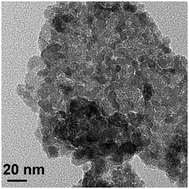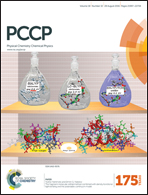Structural, magnetic and electronic properties of Fe1+xGa2−xO4 nanoparticles synthesized by the combustion method
Abstract
The combustion method was used to prepare a precursor powder of an iron-gallium oxide compound which was further heat-treated in order to obtain a set of Fe1+xGa2−xO4 nanoparticles. All samples have a cubic spinel-type structure (space group Fd![[3 with combining macron]](https://www.rsc.org/images/entities/char_0033_0304.gif) m) and the particle size varies from 1.8 to 28.0 nm depending on the treatment conditions. From the comparative analysis by XRD, EDS, and Raman and Mössbauer spectroscopy the creation of a new spinel phase γ-FeGaO3, which was mainly located on the particle surface, was established. As a result, the composition consists of a FeGa2O4 core covered by a FeGaO3 shell. The relative content of FeGa2O4/FeGaO3 compounds in the composites can be varied by heat treatment. The maximum in the ZFC magnetization curves appeared in all samples at about 20–30 K corresponding to the spin-freezing temperature Tsg, which is much higher than in the bulk compound with a pure inverse spinel structure (Ga)[FeGa]O4. The values of effective Curie temperature ΘC for the Fe1+xGa2−xO4 nanoparticles are rather high and positive, indicating a ferromagnetic interaction between iron ions. The high values of the magnetic frustration parameter f = ΘC/Tsg (up to 7) indicate a high degree of magnetic frustration. The low temperature Mössbauer data reveal the magnetic ordering of Fe ions in all samples with the magnetic transition at about 20–26 K depending on the particle size. The specific features of the Mössbauer parameters indicate the properties of non-homogeneous magnetic systems with frustrated interactions specific to spin-glasses. The magnetic system behaves as a spin-glass below Tsg and it is superparamagnetic above Tsg. Such a system is called a “super-spin-glass”. The anisotropy energy Eanis strongly depends on the content of Fe2+ and Fe3+ ions which contribute to the magnetocrystalline Ecryst and exchange Eex anisotropies, respectively. The anisotropy energy can be tuned by variation of the content of the (FeGaO3)–(FeGa2O4) phases in these complex composites.
m) and the particle size varies from 1.8 to 28.0 nm depending on the treatment conditions. From the comparative analysis by XRD, EDS, and Raman and Mössbauer spectroscopy the creation of a new spinel phase γ-FeGaO3, which was mainly located on the particle surface, was established. As a result, the composition consists of a FeGa2O4 core covered by a FeGaO3 shell. The relative content of FeGa2O4/FeGaO3 compounds in the composites can be varied by heat treatment. The maximum in the ZFC magnetization curves appeared in all samples at about 20–30 K corresponding to the spin-freezing temperature Tsg, which is much higher than in the bulk compound with a pure inverse spinel structure (Ga)[FeGa]O4. The values of effective Curie temperature ΘC for the Fe1+xGa2−xO4 nanoparticles are rather high and positive, indicating a ferromagnetic interaction between iron ions. The high values of the magnetic frustration parameter f = ΘC/Tsg (up to 7) indicate a high degree of magnetic frustration. The low temperature Mössbauer data reveal the magnetic ordering of Fe ions in all samples with the magnetic transition at about 20–26 K depending on the particle size. The specific features of the Mössbauer parameters indicate the properties of non-homogeneous magnetic systems with frustrated interactions specific to spin-glasses. The magnetic system behaves as a spin-glass below Tsg and it is superparamagnetic above Tsg. Such a system is called a “super-spin-glass”. The anisotropy energy Eanis strongly depends on the content of Fe2+ and Fe3+ ions which contribute to the magnetocrystalline Ecryst and exchange Eex anisotropies, respectively. The anisotropy energy can be tuned by variation of the content of the (FeGaO3)–(FeGa2O4) phases in these complex composites.


 Please wait while we load your content...
Please wait while we load your content...